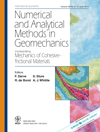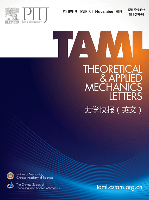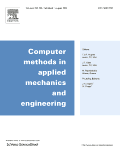
JOURNAL OF ENGINEERING MECHANICS
Scope & Guideline
Elevating Engineering Standards Through Rigorous Research
Introduction
Aims and Scopes
- Structural Dynamics and Analysis:
Research in this area addresses the behavior of structures under dynamic loads, including vibrations, seismic responses, and wind effects. Studies often incorporate advanced modeling techniques and computational methods to predict structural responses. - Material Behavior and Modeling:
This scope includes studies on the mechanical properties of various materials, including concrete, asphalt, and composites. Researchers focus on developing constitutive models that capture the complex behavior of materials under different loading conditions. - Geotechnical Engineering:
Publications frequently explore the interaction between structures and the ground, including soil mechanics, foundation design, and stability analysis. This area is crucial for understanding how geotechnical factors influence structural integrity. - Computational Methods and Simulation:
The journal highlights innovative computational techniques such as finite element analysis, computational fluid dynamics, and machine learning approaches for modeling complex engineering problems. - Reliability and Risk Assessment:
Research on the reliability of structures and systems, including probabilistic methods and risk analysis. This area is vital for ensuring safety and performance in engineering designs. - Dynamics of Fluids and Structures:
Studies that examine fluid-structure interactions, including the effects of wind, water, and other forces on structural performance. This includes research on damping systems and vibration control.
Trending and Emerging
- Machine Learning and Data-Driven Approaches:
The incorporation of machine learning techniques for predictive modeling and system identification is on the rise. This trend emphasizes the importance of data-driven methods in understanding complex engineering systems. - Multiscale Modeling:
Research focusing on multiscale approaches to understand material behavior and structural responses at different scales is gaining popularity. This area allows for better integration of microstructural and macroscopic phenomena. - Advanced Computational Techniques:
There is a growing trend towards utilizing advanced computational methods, including finite element methods and hybrid simulation techniques, to solve complex engineering problems that involve nonlinear behavior and dynamic interactions. - Sustainability and Resilience Engineering:
Research aimed at improving the sustainability and resilience of structures against natural hazards is becoming increasingly important. This includes studies on the performance of materials and structures under extreme conditions. - Interdisciplinary Approaches:
Emerging themes reflect an interdisciplinary approach, combining insights from mechanics, materials science, and computational modeling to address complex engineering challenges.
Declining or Waning
- Traditional Structural Analysis Methods:
There has been a noticeable decline in publications focused on classical methods of structural analysis, such as simplified analytical solutions without modern computational enhancements. Researchers are increasingly favoring more complex, simulation-based approaches. - Basic Material Testing Techniques:
Research solely based on traditional material testing methods has diminished, as there is a growing preference for studies that integrate advanced modeling and computational techniques to predict material behavior. - Static Load Analysis:
The emphasis on static load analysis has waned in favor of dynamic analysis, particularly in the context of structures subjected to environmental loads such as earthquakes and wind. This trend reflects a broader interest in understanding the time-dependent behavior of structures.
Similar Journals

Journal of Theoretical and Applied Mechanics
Connecting Researchers and Practitioners in MechanicsJournal of Theoretical and Applied Mechanics, published by the Polish Society of Theoretical and Applied Mechanics, stands as a leading platform for disseminating cutting-edge research in the realms of theoretical and applied mechanics. With its ISSN 1429-2955 and E-ISSN 1429-2955, this Open Access journal has been fostering academic dialogue since 2006, making knowledge readily accessible to researchers and practitioners alike. Based in Warsaw, Poland, the journal encompasses a wide breadth of topics within mechanics, appealing to a diverse readership including researchers, professionals, and students. The journal's current Scopus ranking places it within the 30th percentile of the field, emphasizing its relevance and contribution to the discipline. As it converges from 2007 to 2024, the Journal of Theoretical and Applied Mechanics is pivotal for those seeking to advance understanding and innovation in mechanical engineering and mathematics, making it an essential resource for anyone involved in these critical areas of study.

INTERNATIONAL JOURNAL FOR NUMERICAL AND ANALYTICAL METHODS IN GEOMECHANICS
Leading the Charge in Geomechanical Research AdvancementsWelcome to the International Journal for Numerical and Analytical Methods in Geomechanics, a prestigious publication dedicated to advancing the fields of geotechnical engineering and computational mechanics. Published by Wiley in the United Kingdom, this journal has been at the forefront of research since its inception in 1977 and continues to provide a vital platform for disseminating innovative methodologies and analytical approaches through 2024. With an impressive impact factor reflecting its excellence, the journal consistently ranks in the Q1 category across multiple domains, including Computational Mechanics, Geotechnical Engineering, and Engineering Geology, making it a key resource for specialists seeking to keep informed on important developments in these areas. Although it does not offer open access, the journal remains highly regarded among researchers and professionals for its rigorous peer-review process and commitment to scientific integrity. As a vital contributor to the field, International Journal for Numerical and Analytical Methods in Geomechanics invites researchers, professionals, and students to explore its comprehensive studies and to advance knowledge at the intersection of numerical analysis and geomechanics.

MECHANICS RESEARCH COMMUNICATIONS
Connecting Theory and Application in EngineeringMECHANICS RESEARCH COMMUNICATIONS, published by PERGAMON-ELSEVIER SCIENCE LTD, is a prestigious journal in the fields of Civil and Structural Engineering, Condensed Matter Physics, Materials Science, and Mechanical Engineering. With an ISSN of 0093-6413 and E-ISSN of 1873-3972, it has made significant contributions to the understanding and advancement of mechanics and materials since its inception in 1974. The journal is well-regarded in academia, holding a Q2 ranking across multiple categories as of 2023, and ranking in the 65th percentile for Mechanical Engineering. Researchers and professionals benefit from its peer-reviewed content, which includes a wide range of articles from fundamental research to applied technological developments. Although currently not an open access journal, it remains a vital resource for those focused on innovating within the engineering and materials science domains. With its established legacy, MECHANICS RESEARCH COMMUNICATIONS continues to shape the discourse in mechanics and engineering, making it essential reading for students and practitioners alike.

Computational Particle Mechanics
Pioneering Research in Fluid Dynamics and Structural EngineeringComputational Particle Mechanics, published by SPRINGER INTERNATIONAL PUBLISHING AG, is a leading journal dedicated to advancing knowledge in the interdisciplinary fields of computational mechanics, civil engineering, and fluid dynamics. With an impressive impact factor reflecting its high-quality research publications, this journal maintains a strong presence in the academic community with a Q1 ranking in categories such as Civil and Structural Engineering, Computational Mechanics, and Numerical Analysis as per the latest 2023 evaluations. Researchers and professionals benefit from the journal's commitment to open-access options, promoting wider dissemination of groundbreaking studies. Operating under the Swiss publishing house since 2014, Computational Particle Mechanics aims to foster innovation through the exploration of particle-based methods and simulations, making significant contributions to methodologies within computational mathematics and modeling. As the journal continues to evolve until its converged years end in 2024, it stands as a vital resource for those looking to enhance their expertise in dynamic modeling and simulation techniques.

Moscow University Mechanics Bulletin
Advancing the Frontiers of Mechanics and EngineeringMoscow University Mechanics Bulletin, published by PLEIADES PUBLISHING INC, is a dedicated journal that has been influencing the fields of mechanical engineering and mechanics since its inception. With an ISSN of 0027-1330 and E-ISSN of 1934-8452, this journal serves as a crucial platform for advancing knowledge in mathematics, mechanical engineering, and mechanics of materials. Though currently indexed in the Q4 category across these disciplines, it offers a unique space for researchers and professionals to engage with emerging theories, experimental results, and practical applications. With a converged publication history spanning from 1973 to 1987, and continuing from 2007 to 2024, the journal remains relevant in today’s academic landscape. Though it operates under traditional access models, the journal's global reach aims to connect diverse voices in engineering research. Aspiring researchers and seasoned professionals alike will find valuable insights and a robust discourse that contribute to their respective fields.

COMPUTATIONAL MECHANICS
Leading the Charge in Computational Engineering ExcellenceCOMPUTATIONAL MECHANICS, published by SPRINGER, is a premier international journal that focuses on the intersection of applied mathematics, engineering, and computational methods. With a commendable Q1 ranking in multiple categories, including Applied Mathematics and Mechanical Engineering, this journal is pivotal for disseminating groundbreaking research and innovative methodologies that advance the field. The journal has steadily contributed to the academic community since its inception in 1986 and continues to lead discussions and practices in computational mechanics and related disciplines. With a robust impact reflected in its Scopus rankings—placing it within the top percentiles across various categories—COMPUTATIONAL MECHANICS serves as a crucial platform for researchers, professionals, and students seeking to explore and contribute to significant advancements in computational theory and mathematical applications. Although it does not currently operate under an open access model, the journal ensures wide accessibility through libraries and institutional subscriptions, fostering a rich exchange of knowledge in the global scientific community.

International Journal of Mechanics and Materials in Design
Transforming Ideas into Engineering ExcellenceInternational Journal of Mechanics and Materials in Design is a leading publication in the field of mechanical engineering and materials science, published by Springer Heidelberg. With an impressive impact factor, it holds esteemed rankings as Q1 in both Mechanical Engineering and Mechanics of Materials, and Q2 in Materials Science for the year 2023, solidifying its reputation as a significant contributor to the advancement of design methodologies. The journal focuses on the intersection of mechanics and materials, encouraging innovative research that addresses contemporary challenges faced in engineering disciplines. Researchers and professionals alike can benefit from accessing cutting-edge studies contributing to various applications, making it an invaluable resource for staying informed in this dynamic field. While the journal operates under a subscription model, its comprehensive reviews and high-quality original research foster a deeper understanding of material behavior and design principles, thus supporting the academic growth and professional development of its readers.

ARCHIVES OF MECHANICS
Exploring New Dimensions in Mechanics Since 1971Archives of Mechanics, published by the Polish Academy of Sciences Institute of Fundamental Technological Research, is a distinguished open-access journal established in 1971 that has played a pivotal role in the dissemination of knowledge in the fields of Mechanical Engineering and Condensed Matter Physics. With its commitment to accessibility since adopting open access in 2022, this journal provides a platform for researchers, professionals, and students to share cutting-edge research findings and innovative methodologies. Although it currently holds a Q4 ranking in Condensed Matter Physics and a Q3 ranking in Mechanical Engineering for 2023, its comprehensive scope, which spans critical advancements in mechanical systems and materials science, positions it as a valuable resource for the academic community. Located in Warsaw, Poland, the journal continues to contribute significantly to the global discourse on mechanics and is dedicated to fostering new ideas that advance both theoretical and applied aspects of the discipline.

Theoretical and Applied Mechanics Letters
Exploring Cutting-Edge Solutions in Engineering DisciplinesTheoretical and Applied Mechanics Letters, published by ELSEVIER, stands as a premier journal in the field of engineering and applied mechanics, recognized for its rigorous peer-reviewed articles that advance theoretical and practical frameworks. With an impressive open access policy established in 2015, the journal enhances global accessibility to cutting-edge research across a range of disciplines including Aerospace, Civil, Mechanical, and Biomedical Engineering, along with Computational Mechanics and Ocean Engineering. The journal boasts an enviable position in the academic landscape, achieving a Q1 rank in several categories as of 2023, while being cited among the top percentiles in Scopus Ranks, specifically ranking #25 in Aerospace Engineering and #15 in Computational Mechanics. The journal aims to foster innovation by providing a platform for scholars and professionals to disseminate their findings, thereby bridging the gap between theoretical research and practical applications. By promoting a diverse range of topics and methodologies, Theoretical and Applied Mechanics Letters not only contributes to the advancement of engineering disciplines but also supports the global academic community in exploring sustainable and impactful engineering solutions.

COMPUTER METHODS IN APPLIED MECHANICS AND ENGINEERING
Exploring Innovations at the Intersection of Engineering and Computation.COMPUTER METHODS IN APPLIED MECHANICS AND ENGINEERING, published by Elsevier Science SA, is a premier journal that has significantly contributed to the fields of computational mechanics, computer science applications, mechanical engineering, and the mechanics of materials since its inception in 1972. With an ISSN of 0045-7825 and an E-ISSN of 1879-2138, this journal is recognized for its rigorous peer-review process and is consistently ranked in the Q1 quartile across multiple categories, including Computational Mechanics and Mechanical Engineering. Its impressive Scopus rankings place it in the top tiers of its field, with a percentile ranking of 98th in Computational Mechanics. Researchers, professionals, and students will find the journal's comprehensive scope and high-quality articles invaluable for advancing their knowledge and practices at the intersection of engineering and computation. Although not an open-access journal, its impactful contributions to both theoretical and applied research make it an essential resource for anyone involved in these dynamic fields.